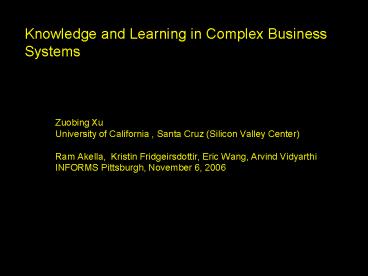Knowledge and Learning in Complex Business Systems - PowerPoint PPT Presentation
Title:
Knowledge and Learning in Complex Business Systems
Description:
analysis. Corrective. actions. Inspection. Validation. Goal ... information as it arrives by incorporating it into the new product or process under development ... – PowerPoint PPT presentation
Number of Views:28
Avg rating:3.0/5.0
Title: Knowledge and Learning in Complex Business Systems
1
Knowledge and Learning in Complex Business Systems
- Zuobing Xu
- University of California , Santa Cruz (Silicon
Valley Center) - Ram Akella, Kristin Fridgeirsdottir, Eric Wang,
Arvind Vidyarthi - INFORMS Pittsburgh, November 6, 2006
2
Overview Perspective on Learning and Knowledge
- - Semiconductor process learning (KLA, AMD,
INTEL) - - Automotive product development learning
(Delphi) - - IT service center knowledge mining and
learning (IBM, Cisco)
3
Perspective on Learning and Knowledge - 1
- Semiconductor process yield management and
learning. - The models were new, but still in the OR
framework
4
Perspective on Learning and Knowledge - 2
- In the automotive environment, OR modeling ran
into a roadblock - Forced to learn ontology to speed up learning in
new product development - Subsequently, discovered that learning and
knowledge management are closely related to text
mining and information retrieval, Applicable in
airlines, health care , service/call centers
5
Perspective on Learning and Knowledge - 3
- IT Service Center
- - Millions of documents (services call logs,
Technical documents) - - We use text mining and information retrieval to
manage and extract knowledge efficiently.
6
Is There a Unifying Framework for Knowledge and
Learning?
- Do not know, but..
- Need to combine
- Operations Management
- Knowledge Management
- Text Mining
- Specific research examples follow
7
Process Learning in the Semiconductor Industry
8
In-line Monitoring for Semiconductor
Product-Process Learning and Manufacturing
Isolation
Metal 2
Poly 1
Poly2
Metal 1
Wafer Probe
Off-line Review
Depo
Etch
or
In-line ADC
Photo
Wafer processing
Inspection
Classification
10 days
30 days
Yield
9
Business Need
- Methodology For rapid product and process
learning - How to use inspection machines to improve yield
per machine
10
REDEFINED GOAL MINIMIZING TIME TO DETECT AND FIX
YIELD EXCURSION ( AN EXCURSION _at_ ETCHER IN FAB A)
EventOccurring
EventDetected
Source Isolated
Fix Validated
50
7
20
9
2
17
Hours
Detection Delay
SourceIsolation
RootCause Analysis
Corrective Actions
In- Control
Defect level
- Goal
- Optimize procedures and inspection-review machine
usage to reduce delay to detect and fix yield
excursion - Using defects as surrogates ( linking defects to
yield is a technology problem in
electrical/computer engineering)
11
Conversion Of Defect Data To Yield Information
And Action
Isolation
Poly1
Poly2
Metal1
Metal2
Market
Inspection
Validation
Review classification
Corrective actions
Resources strategies
Source identification
Root-cause analysis
Data/information flow
12
Analytics
- Developed generalized Neyman-Pearson Lemma for
multi-dimensional control charts - Model queuing effects of inspection-review-isolati
on-fix-validation cycle
13
Business and Knowledge Management in the
Automotive Industry
14
Shift in Learning Paradigm From Numerical to
Text
Knowledge and learning are now associated with
text Traditional OR models cannot be directly
used! What do we do?
15
Triggered Learning Process Dynamic Ontology
Usage
- TLP is a structured approach that
- Feeds back lessons learned created by downstream
organizational personnel - To a staff that condenses these lessons learned
into an ontology and, - Communicates these items to NPD
- NPD personnel reacts to this information as it
arrives by incorporating it into the new product
or process under development
Step 1 Feedback
Lessons Learned Ontology
First time quality
Safety and ergonomics
Formal OEM complaints
Warranty
Long-term durability
Step 2 Update
Step 3 Communicate
Customer
GM
Dealer
Production
OEM
Field lt3 yrs
Field gt3 yrs
Delphi
GM
Dealer
Customer
Step 4 React
16
Step 2 Update Ontology
- Staff used
- To summarize the Lesson Learned in the ontology
- Attach the Lesson Learned documents provided
17
Business and Knowledge Management in IT Services
18
Service Center Work Flow
19
Improve IT Service Performance by Text Mining and
Information Retrieval
- - Text Mining Organize Technical
Documentation Automatically - - Information Retrieval Retrieve and Find
the Correct Solution - Can we trust computer algorithm?
- We need human guidance ( Relevance Feedback).
- How can we reduce human effort ?
- - Active learning ( Actively selecting document
for human evaluation )
20
Active Learning in Information Retrieval
Retrieval Engines Ranking d13.4 d22.0 d101
.0
Retrieval Engine
Query
Service Engineer or Customer
Document Collection
Judgments d1(Non-relevant) d2(Non-relevant) d1
0 (Relevant)
Query Update
Feedback
21
Active Learning to Choose Feedback Documents
- Goal choose a set of documents containing most
information for user to evaluate. - Relevance Select highly ranked retrieval
documents given by search engine - Diversity Increase distance between selected
documents . - Density Choose document in high density region.
22
Experimental Results
Mean Average Precision (MAP) - Measure of
overall ranking accuracy. Precision at 10
documents(Pr_at_10) - Measure of the precision
for the first 10 documents.
23
Organize Documents
- - Technical documents and case logs always have
some meta data indicating its product category. - But problem description, root cause , solution
are not well categorized. - Design a new active semi-supervised text
clustering algorithm to group documents.
24
Text Mining Semi-supervised clustering with
pair-wise constraints (Organize Trouble Tickets)
Can not be linked!!!!
25
Future Research for Knowledge Management of
Service Center
- - Using OR to model the benefit and cost for
human interaction. - - Feed the lessons learned from service center
to New product develop process. - - Combine text analytics with call center
scheduling.
26
Conclusions Unified Model for Knowledge and
Learning
Goal
Data (Defect signal, Documents)
Knowledge Management
Information
Reduce operations cost Increase
overall efficiency
Statistical Detection Building Ontology Text
Clustering Information Retrieval
Queuing Model Resource Allocation































